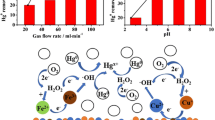Abstract
The aim of this work is to investigate the use of a new type of reactor for electroorganic synthesis. The concept of the reactor is based on the principle of the porous percolated pulsed electrode (E3P) which was primarily developed at commercial scale for metal recovery in waste waters. The reactor is fitted with a three-dimensional electrode, of axial configuration, consisting of ordered stacks of discs of expanded metal. It can be supplied either by a homogeneous electrolyte or by an emulsion generated by an external ultrasonic system. The pulsation of the electrolyte represents a very effective means of improving mass transfer rates at the electrode. Under two phase conditions, the role of the pulsation is also to ensure the hydraulic transport of the emulsion and to increase the three phase contacts between the aqueous phase, the organic phase and the electrode. The efficiency of the reactor was tested using both homogeneous and two phase liquid–liquid electrolytes in the direct reduction process of an aromatic ketone. This study reports the effects of the pulsation on the mass transfer rate of acetophenone at the electrode. A comparative study of the behaviour of the E3P reactor towards different media is accomplished. Particular attention is paid to the chemical and faradaic yields, as well as to the selectivity of the reaction.
Similar content being viewed by others
References
M. M. Baizer (ed.), ‘Organic Electrochemistry’, Marcel Dekker, New York, 3rd. ed. (1991).
A. Savall, Actual. Chim. 1-2 (1992) 35.
G. Lacoste, Eur.patent, 0 302 891, (1991) Institut National Polytechnique de Toulouse.
F. Coeuret and A. Storck, ‘Eléments de Génie Electrochimique’, Technique et Documentation (Lavoisier), Paris (1984).
C. Gaschet, Thèse de doctorat I.N.P.T., Toulouse (1991).
P. Cognet, J. Berlan, G. Lacoste, P.-L. Fabre and J.-M. Jud, J. Appl. Electrochem. 25(1995) 1105.
P. Cognet, J. Berlan, G. Lacoste, P.-L. Fabre and J.-M. Jud, ibid. 26 (1996) 631.
M. M. Quéméré, Thèse de l'Université de Rennes 1, E.N.S.C.R., (1984).
M. Jaccaud, French patent Produits Chimiques Ugine Kulhman, 2 490 683 (1982).
F. Leroux, Thèse de l'Université de Poitiers (1992).
F. Coeuret and F. Leroux, Electrochim. Acta 28 (1983) 1857.
T. J. Mason, J. P Lorimer and D. J. Walton, Ultrasonics 28 (1990) 333.
E. Laviron and J. C. Lucy, Bull. Soc. Chim. Fr. (1966) 2202.
D. Brown and L. Horner, Liebigs Ann. Chem. (1977) 77.
S. G. Mairanovskii and V. N. Pavlov, Russ. J. Phys. Chem. 38 (1964) 980.
A. Honnorat and P. Martinet, Electrochim. Acta 28 (1983) 1703.
C. A. Amatore, L. Nadjo and J. M. Saveant, J. Electroanal, Chem. 90 (1978) 321.
C. P. Andrieu, J.M. Dumas-Bouchat and J. M. Saveant, ibid 83 (1977) 355.
M. M. Baizer (ed.), ‘Organic Electrochemistry’, Marcel Dekker, New York, 3rd. ed. (1991), chapter 10 p 433 and chapter 22 p 893.
A. Tallec, ‘Electrochimie organique-synthèses et mécanismes’, Masson, Paris (1985).
P. J. Elving and J. T. Leone, J. Am. Chem. Soc. 80 (1958) 1021.
Le Métal Déployé SA, 383 Avenue du général de Gaulle, B. P. 203, 92142 Clamart, France.
C. Furiet, G. Valentin and A. Storck, Bull. Soc. Chim. France 6 (1985) 1061.
Author information
Authors and Affiliations
Rights and permissions
About this article
Cite this article
Belmant, C., Cognet, P., Berlan, J. et al. Application of an electrochemical pulsed flow reactor to electroorganic synthesis: Part I: Reduction of acetophenone. Journal of Applied Electrochemistry 28, 185–191 (1998). https://doi.org/10.1023/A:1003282709485
Issue Date:
DOI: https://doi.org/10.1023/A:1003282709485




